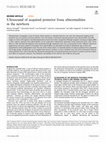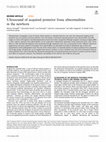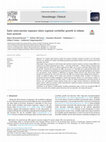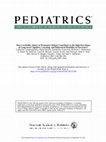Papers by Catherine Limperopoulos

Pediatric Research, Mar 1, 2020
5 on behalf of the eurUS.brain group Neonatal brain sonography is part of routine clinical practi... more 5 on behalf of the eurUS.brain group Neonatal brain sonography is part of routine clinical practice in neonatal intensive care units, but ultrasound imaging of the posterior fossa has gained increasing attention since the burden of perinatal acquired posterior fossa abnormalities and their impact on motor and cognitive neurodevelopmental outcome have been recognized. Although magnetic resonance imaging (MRI) is often superior, posterior fossa abnormalities can be suspected or detected by optimized cranial ultrasound (CUS) scans, which allow an early and bedside diagnosis and monitoring through sequential scans over a long period of time. Different ultrasound appearances and injury patterns of posterior fossa abnormalities are described according to gestational age at birth and characteristics of the pathogenetic insult. The aim of this review article is to describe options to improve posterior fossa sequential CUS image quality, including the use of supplemental acoustic windows, to show standard views and normal ultrasound anatomy of the posterior fossa, and to describe the ultrasound characteristics of acquired posterior fossa lesions in preterm and term infants with effect on long-term outcome. The limitations and pitfalls of CUS and the role of MRI are discussed.
ABSTRACT Introduction Advanced post-processing techniques of three-dimensional magnetic resonance... more ABSTRACT Introduction Advanced post-processing techniques of three-dimensional magnetic resonance imaging (3D MRI) data are increasingly used to analyze structural changes related to acquired injury or disease, growth and development, and plasticity in the brain. One of the newest types of such analyses is the assessment of growth patterns of different structures of the human brain. This type of analysis is particularly suited to the evaluation of the human infant’s brain in its period of dynamic growth and development. Such an approach may be extremely useful in studying the impact of premature birth and/or early acquired brain injury on the developing infant brain. Thompson et al. used four-dimensional quantitative maps of growth patterns of the brain of children aged
Journal of Neonatal-Perinatal Medicine

NeuroImage, 2020
Brain structural changes in premature infants appear before term age. Functional differences betw... more Brain structural changes in premature infants appear before term age. Functional differences between premature infants and healthy fetuses during this period have yet to be explored. Here, we examined brain connectivity using resting state functional MRI in 25 very premature infants (VPT; gestational age at birth <32 weeks) and 25 healthy fetuses with structurally normal brain MRIs. Resting state data were evaluated using seed-based correlation analysis and network-based statistics using 23 regions of interest (ROIs) per hemisphere. Functional connectivity strength, the Pearson correlation between blood oxygenation level dependent signals over time across all ROIs, was compared between groups. In both cohorts, connectivity between homotopic ROIs showed a decreasing medial to lateral gradient. The cingulate cortex, medial temporal lobe and the basal ganglia shared the strongest connections. In premature infants, connections involving superior temporal, hippocampal, and occipital areas, among others, were stronger compared to fetuses. Premature infants showed stronger connectivity in sensory input and stress-related areas suggesting that extra-uterine environment exposure alters the development of select neural networks in the absence of structural brain injury.

Pediatric Research, 2020
Neonatal brain sonography is part of routine clinical practice in neonatal intensive care units, ... more Neonatal brain sonography is part of routine clinical practice in neonatal intensive care units, but ultrasound imaging of the posterior fossa has gained increasing attention since the burden of perinatal acquired posterior fossa abnormalities and their impact on motor and cognitive neurodevelopmental outcome have been recognized. Although magnetic resonance imaging (MRI) is often superior, posterior fossa abnormalities can be suspected or detected by optimized cranial ultrasound (CUS) scans, which allow an early and bed-side diagnosis and monitoring through sequential scans over a long period of time. Different ultrasound appearances and injury patterns of posterior fossa abnormalities are described according to gestational age at birth and characteristics of the pathogenetic insult. The aim of this review article is to describe options to improve posterior fossa sequential CUS image quality, including the use of supplemental acoustic windows, to show standard views and normal ultr...
Epilepsia, 2019
SummaryIn a prospective cohort of 534 neonates with acute symptomatic seizures, 66% had incomplet... more SummaryIn a prospective cohort of 534 neonates with acute symptomatic seizures, 66% had incomplete response to the initial loading dose of antiseizure medication (ASM). Treatment response did not differ by gestational age, sex, medication, or dose. The risk of incomplete response was highest for seizures due to intracranial hemorrhage and lowest for hypoxic‐ischemic encephalopathy, although the difference was not significant after adjusting for high seizure burden and therapeutic hypothermia treatment. Future trial design may test ASMs in neonates with all acute symptomatic seizure etiologies and could target neonates with seizures refractory to an initial ASM.

NeuroImage: Clinical, 2018
To compare third trimester global and regional cerebellar volumetric growth at two time-points be... more To compare third trimester global and regional cerebellar volumetric growth at two time-points between very preterm (PT) infants and healthy gestational age-matched fetuses in the PT period and at term equivalent age (TEA). Study design: Using a prospective study design, high resolution anatomic magnetic resonance images (MRI) were acquired in PT infants (gestational age at birth < 32 weeks; birthweight < 1500 g) without cerebellar injury and healthy full-term controls. PT infants completed two MRIs, one as soon as medically stable and the other around TEA. Controls also completed two MRIs, one in utero (i.e. fetal MRI) and a postnatal MRI shortly after birth. The cerebellum of each participant was parcellated into 5 regions: left and right hemispheres, the anterior, neo and posterior vermis. Evidence of differences in regional volumes between term and pre-term infants matched for gestational age (GA) at the time of the first MRI were assessed using multiple linear regression. Results: we studied 76 subjects: 38 PT infants were matched to 38 healthy fetuses. At MRI-1, PT infants demonstrated decreased cerebellar hemispheric volumes and increased anterior, neo-and posterior vermian regional volumes when compared to healthy fetuses. At TEA, PT infants demonstrated a persistent increase in anterior, neo-and posterior vermian regional volumes but no longer showed reductions in cerebellar hemispheric volume. Only the neovermis volume demonstrated a significant negative association with birthweight, male gender and supratentorial injury. Conclusions: In the absence of demonstrable cerebellar parenchymal injury evident on conventional MRI, PT birth is associated with cerebellar growth alterations that are regionally-and temporally-specific.

Cerebral cortex (New York, N.Y. : 1991), Jan 31, 2016
This study characterizes global and hemispheric brain growth in healthy human fetuses during the ... more This study characterizes global and hemispheric brain growth in healthy human fetuses during the second half of pregnancy using three-dimensional MRI techniques. We studied 166 healthy fetuses that underwent MRI between 18 and 39 completed weeks gestation. We created three-dimensional high-resolution reconstructions of the brain and calculated volumes for left and right cortical gray matter (CGM), fetal white matter (FWM), deep subcortical structures (DSS), and the cerebellum. We calculated the rate of growth for each tissue class according to gestational age and described patterns of hemispheric growth. Each brain region demonstrated major increases in volume during the second half of gestation, the most pronounced being the cerebellum (34-fold), followed by FWM (22-fold), CGM (21-fold), and DSS (10-fold). The left cerebellar hemisphere, CGM, and DSS had larger volumes early in gestation, but these equalized by term. It has been increasingly recognized that brain asymmetry evolves ...

The Journal of Pediatrics, 2016
Objective-To examine the extent to which weight gain and weight status in the first 2 years of li... more Objective-To examine the extent to which weight gain and weight status in the first 2 years of life relate to the risk of neurodevelopmental impairment in extremely preterm infants. Study Design-In a cohort of 1070 infants born between 23 and 27 weeks' gestation, we examined weight gain from 7-28 days of life (in quartiles) and weight z-score at 12 and 24 months corrected age (in categories: <−2; ≥−2, <−1; ≥1, <1; ≥1) in relation to these adverse neurodevelopmental outcomes: Bayley-II mental development index <55, Bayley-II psychomotor development index <55, cerebral palsy, Gross Motor Function Classification System (GMFCS) ≥1 (cannot walk without assistance), microcephaly. We adjusted for confounders in logistic regression, stratified by sex, and performed separate analyses including the entire sample, and excluding children unable to walk without assistance (motor impairment). Results-Weight gain in the lowest quartile from 7-28 days was not associated with higher risk of adverse outcomes. Children with a 12-month weight z-score <−2 were at increased risk for all adverse outcomes in girls, and for microcephaly and GMFCS ≥1 in boys. However, excluding children with motor impairment attenuated all associations except that of weight z-score <−2 with microcephaly in girls. Similarly, most associations of low weight z-score at 24 months with adverse outcomes were attenuated with exclusion of children with motor impairment.
Introduction Advanced post-processing techniques of three-dimensional magnetic resonance imaging ... more Introduction Advanced post-processing techniques of three-dimensional magnetic resonance imaging (3D MRI) data are increasingly used to analyze structural changes related to acquired injury or disease, growth and development, and plasticity in the brain. One of the newest types of such analyses is the assessment of growth patterns of different structures of the human brain. This type of analysis is particularly suited to the evaluation of the human infant’s brain in its period of dynamic growth and development. Such an approach may be extremely useful in studying the impact of premature birth and/or early acquired brain injury on the developing infant brain. Thompson et al. used four-dimensional quantitative maps of growth patterns of the brain of children aged

The Cerebellum, 2014
Cerebellar injury is increasingly recognized as an important complication of very preterm birth. ... more Cerebellar injury is increasingly recognized as an important complication of very preterm birth. However, the neurodevelopmental consequences of early life cerebellar injury in prematurely born infants have not been well elucidated. We performed a literature search of studies published between 1997 and 2014 describing neurodevelopmental outcomes of preterm infants following direct cerebellar injury or indirect cerebellar injury/underdevelopment. Available data suggests that both direct and indirect mechanisms of cerebellar injury appear to stunt cerebellar growth and adversely affect neurodevelopment. This review also provides important insights into the highly integrated cerebral-cerebellar structural and functional correlates. Finally, this review highlights that early life impairment of cerebellar growth extends far beyond motor impairments and plays a critical, previously underrecognized role in the long-term cognitive, behavioral, and social deficits associated with brain injury among premature infants. These data point to a developmental form of the cerebellar cognitive affective syndrome previously described in adults. Longitudinal prospective studies using serial advanced magnetic resonance imaging techniques are needed to better delineate the full extent of the role of prematurity-related cerebellar injury and topography in the genesis of cognitive, social-behavioral dysfunction.

Pediatrics, 2009
OBJECTIVES: Cerebral pressure passivity is common in sick premature infants and may predispose to... more OBJECTIVES: Cerebral pressure passivity is common in sick premature infants and may predispose to germinal matrix/intraventricular hemorrhage (GM/IVH), a lesion with potentially serious consequences. We studied the association between the magnitude of cerebral pressure passivity and GM/IVH. PATIENTS AND METHODS: We enrolled infants <32 weeks' gestational age with indwelling mean arterial pressure (MAP) monitoring and excluded infants with known congenital syndromes or antenatal brain injury. We recorded continuous MAP and cerebral near-infrared spectroscopy hemoglobin difference (HbD) signals at 2 Hz for up to 12 hours/day and up to 5 days. Coherence and transfer function analysis between MAP and HbD signals was performed in 3 frequency bands (0.05–0.25, 0.25–0.5, and 0.5–1.0 Hz). Using MAP-HbD gain and clinical variables (including chorioamnionitis, Apgar scores, gestational age, birth weight, neonatal sepsis, and Score for Neonatal Acute Physiology II), we built a logistic ...

Pediatrics, 2007
OBJECTIVE. Hypotension is a commonly treated complication of prematurity, although definitions an... more OBJECTIVE. Hypotension is a commonly treated complication of prematurity, although definitions and management guidelines vary widely. Our goal was to examine the relationship between current definitions of hypotension and early abnormal cranial ultrasound findings. METHODS. We prospectively measured mean arterial pressure in 84 infants who were ≤30 weeks’ gestational age and had umbilical arterial catheters in the first 3 days of life. Sequential 5-minute epochs of continuous mean arterial pressure recordings were assigned a mean value and a coefficient of variation. We applied to our data 3 definitions of hypotension in current clinical use and derived a hypotensive index for each definition. We examined the association between these definitions of hypotension and abnormal cranial ultrasound findings between days 5 and 10. In addition, we evaluated the effect of illness severity (Score for Neonatal Acute Physiology II) on cranial ultrasound findings. RESULTS. Acquired lesions as sh...

Pediatrics, 2005
Background. Advanced neuroimaging techniques have brought increasing recognition of cerebellar in... more Background. Advanced neuroimaging techniques have brought increasing recognition of cerebellar injury among premature infants. The developmental relationship between early brain injury and effects on the cerebrum and cerebellum remains unclear. Objectives. To examine whether cerebral parenchymal brain lesions among preterm infants are associated with subsequent decreases in cerebellar volume and, conversely, whether primary cerebellar injury is associated with decreased cerebral brain volumes, with advanced, 3-dimensional, volumetric MRI at term gestational age equivalent. Methods. Total cerebellar volumes and cerebellar gray and myelinated white matter volumes were determined through manual outlining for 74 preterm infants with unilateral periventricular hemorrhagic infarction (14 infants), bilateral diffuse periventricular leukomalacia (20 infants), cerebellar hemorrhage (10 infants), or normal term gestational age equivalent MRI findings (30 infants). Total brain and right/left c...

Pediatrics, 2007
OBJECTIVE. Although cerebellar hemorrhagic injury is increasingly diagnosed in infants who surviv... more OBJECTIVE. Although cerebellar hemorrhagic injury is increasingly diagnosed in infants who survive premature birth, its long-term neurodevelopmental impact is poorly defined. We sought to delineate the potential role of cerebellar hemorrhagic injury in the long-term disabilities of survivors of prematurity. DESIGN. We compared neurodevelopmental outcome in 3 groups of premature infants (N = 86; 35 isolated cerebellar hemorrhagic injury, 35 age-matched controls, 16 cerebellar hemorrhagic injury plus supratentorial parenchymal injury). Subjects underwent formal neurologic examinations and a battery of standardized developmental, functional, and behavioral evaluations (mean age: 32.1 ± 11.1 months). Autism-screening questionnaires were completed. RESULTS. Neurologic abnormalities were present in 66% of the isolated cerebellar hemorrhagic injury cases compared with 5% of the infants in the control group. Infants with isolated cerebellar hemorrhagic injury versus controls had significant...

Pediatrics, 2006
OBJECTIVE. Early diagnosis of periventricular hemorrhagic infarction in premature infants is base... more OBJECTIVE. Early diagnosis of periventricular hemorrhagic infarction in premature infants is based on bedside neonatal cranial ultrasonography. Currently, evaluation of its morphology and evolution by cranial ultrasound relies largely on data predating major advances in perinatal care and lacks a consistent classification system for determining severity of injury. The objective of this study was to examine the ultrasonographic morphology and evolution of periventricular hemorrhagic infarction in the modern NICU and to determine the value of a cranial ultrasonography-based severity score for predicting outcome.METHODS. We retrospectively evaluated all cranial ultrasounds and medical records of 58 premature infants with periventricular hemorrhagic infarction. We assigned each subject a severity score based on extent of echodensity, unilateral versus bilateral, and presence or absence of midline shift. A neurologic examination was performed after 12 months adjusted age.RESULTS. The par...

Pediatrics, 2007
OBJECTIVES. Periventricular hemorrhagic infarction is a serious complication of germinal matrix-i... more OBJECTIVES. Periventricular hemorrhagic infarction is a serious complication of germinal matrix-intraventricular hemorrhage in premature infants. Our objective was to determine the neurodevelopmental and adaptive outcomes of periventricular hemorrhagic infarction survivors and identify early cranial ultrasound predictors of adverse outcome.METHODS. We retrospectively evaluated all cranial ultrasounds of 30 premature infants with periventricular hemorrhagic infarction and assigned a cranial ultrasound–based periventricular hemorrhagic infarction severity score (range: 0–3) on the basis of whether periventricular hemorrhagic infarction (1) involved ≥2 territories, (2) was bilateral, or (3) caused midline shift. We then performed neuromotor, visual function, and developmental evaluations (Mullen Scales of Early Learning, Vineland Adaptive Behavior Scale). Developmental scores below 2 SD from the mean were defined as abnormal.RESULTS. Median adjusted age at evaluation was 30 months (ran...

Pediatrics, 2008
OBJECTIVES. The objectives of this study were to examine the circulatory changes experienced by t... more OBJECTIVES. The objectives of this study were to examine the circulatory changes experienced by the immature systemic and cerebral circulations during routine events in the critical care of preterm infants and to identify clinical factors that are associated with greater hemodynamic-oxygenation changes during these events.METHODS. We studied 82 infants who weighed <1500 g at birth and required intensive care management and continuous blood pressure monitoring from an umbilical arterial catheter. Continuous recording of cerebral and systemic hemodynamic and oxygenation changes was performed. We studied 6 distinct types of caregiving events during 10-minute epochs: (1) quiet baseline periods; (2) minor manipulation; (3) diaper changes; (4) endotracheal tube suctioning; (5) endotracheal tube repositioning; and (6) complex events. Each event was matched with a preceding baseline. We examined the effect of specific clinical factors and cranial ultrasound abnormalities on the systemic ...

Pediatrics, 2005
Objective. Cognitive impairments and academic failure are commonly reported in survivors of prete... more Objective. Cognitive impairments and academic failure are commonly reported in survivors of preterm birth. Recent studies suggest an important role for the cerebellum in the development of cognitive and social functions. The objective of this study was to examine the impact of prematurity itself, as well as prematurity-related brain injuries, on early postnatal cerebellar growth with quantitative MRI. Methods. Advanced 3-dimensional volumetric MRI was performed and cerebellar volumes were obtained by manual outlining in preterm (<37 weeks) and healthy term-born infants. Intracranial and total brain volumes were also calculated. Results. A total of 169 preterm and 20 healthy full-term infants were studied; 145 had preterm MRI (pMRI), 75 had term MRI (tMRI), and 51 underwent both pMRI and tMRI. From 28 weeks’ postconceptional age to term, mean cerebellar volume (177%) in preterm infants increased at a much faster rate than did mean intracranial (110%) or mean brain (107%) volumes. ...










Uploads
Papers by Catherine Limperopoulos